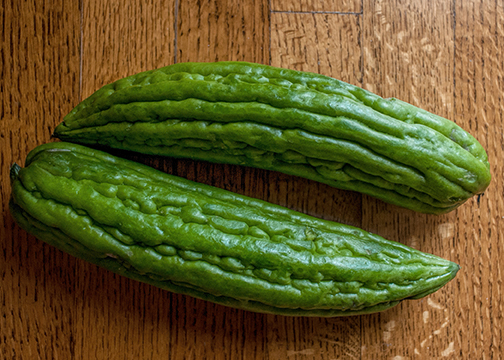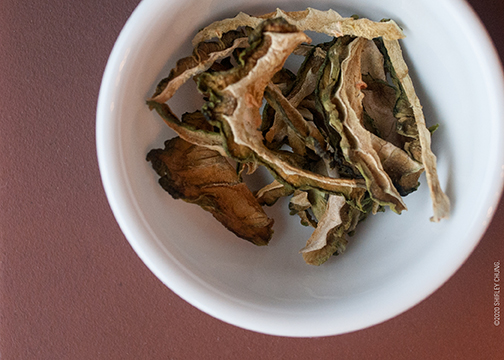

Momordica charantia
The Chinese bitter melon/cucumber (of the Cucurbitaceae family) is shaped like a large American cucumber. Bitter melon (typically 7-9 inches in length) has a very deeply “wrinkled-looking” grass-green (as opposed to the darker colored skin of the American cucumber) soft skin and has tapered ends.
Habitat/Growing Information.
The plant prefers heat (warm to hot) & moisture–a somewhat tropical climate for at least 3-4 months to grow to maturity. Plant them late spring or when the weather is consistently 75 to 80 degrees F. Like cucumbers, the bitter melon grows on a vine. Trellises may be useful to keep the growing melons from touching the ground. Keep the soil moist and well-drained–not waterlogged. Harvest while it is green–at its best. As it ripens/over-ripens it goes from green to yellow to orange. Each plant produces 10-12 melons.
Parts utilized.
Similar to the cucumber, the flesh is used (sometimes dehydrated) and the seeds are discarded. You can use it to stir-fry or even stuffed or in soups.

Properties.
The amount of bitterness depends on the melon’s color. Green bitter melons tend to be the most bitter; white bitter melons are less bitter. As a member of the Cucurbitaceae family, these vegetables are rich in phenolic compounds, vitamin A and C and iron (Islam & Jalaluddin, 2019). The bitter melon also had higher contents of potassium, calcium, magnesium, dietary fiber, niacin, thiamin, and riboflavin than other more common staple vegetables found in grocery stores (Islam & Jalaluddin, 2019 ).
Other researchers have found the bitter melon’s effects to be antioxidant, anti-diabetic, anti-ulcerogenic, anti-tumor, antimutagenic, anti-lipolytic, analgesic, antiviral, analgesic, abortifacient, hypoglycemic, and immunomodulatory (Islam & Jalauddin, 2019; Jia, Shen, Zhang, & Xie, 2017; Shivanagoudra et al., 2019).
Shivanagoudra et al. (2019) found bitter melon extracts to stimulate insulin secretion from pancreatic cells, to protect pancreatic B-cells from inflammation, and to reduce lipid proliferation in adipocytes.
Bitter melon has been used for hundreds of years in Asia, but further research is needed to uncover all of its “secrets” including a dose-response profile.
References
- https://www.thespruceeats.com/the-best-bitter-melon-recipes-4071414
- https://plants.usda.gov/core/profile?symbol=MOCH2
- https://harvesttotable.com/how-to-grow-bitter-melon/
- Islam, S., & Jalaluddin, M. (2019). Biological Functions and Sensory Attributes of Different Skin Colored Bitter Melon (Momordica charantia L.) Varieties. American Journal of Food Science and Health, 5(2), 25-31.
- Jia, S., Shen, M., Zhang, F., & Xie, J. (2017). Recent advances in Momordica charantia: functional components and biological activities. International journal of molecular sciences, 18(12), 2555.
- Shivanagoudra, S. R., Perera, W. H., Perez, J. L., Athrey, G., Sun, Y., Wu, C. S., … & Patil, B. S. (2019). In vitro and in silico elucidation of antidiabetic and anti-inflammatory activities of bioactive compounds from Momordica charantia L. Bioorganic & medicinal chemistry.
